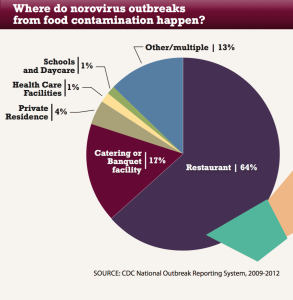Being in France, I’m reminded that on June 20, 2015, about 1,000 of the almost 8,400 runners who took part in Mud Day activities in Nice on the French Riviera were stricken with gastroenteritis.
 And now, the paper.
And now, the paper.
An acute gastroenteritis (AG) outbreak occurred among participants in an obstacle race in France in the summer of 2015.
An investigation in two phases was conducted to identify the source of infection and document the extent of the outbreak.
First, a message on a social media website asked racers to report any symptoms by email to the Regional Health Agency of Provence-Alpes-Côte d’Azur. Second, a retrospective cross-sectional study was conducted through an interactive questionnaire for all participants, followed by an analytical study of potential risks factors.
Of 8,229 persons registered, 1,264 adults reported AG resolved within 48 hours. Of adults who reported AG, 866 met the case definition. Age group, departure time and ingestion of mud were associated with AG. Twenty stool specimens tested negative for bacteria. All four stool samples tested for viruses were positive for Norovirus genogroup I and genotype 2. No indicator bacteria for faecal contamination were found in drinking water but muddy water of ponds tested positive.
The outbreak was possibly caused by human-to-human transmission of a norovirus introduced by one or more persons and transmitted through contaminated mud. Risks related to similar races should be assessed and recommendations be proposed to raise awareness among health authorities and organisers.
Outbreak of diarrhoeal illness in participants in an obstacle adventure race, Alpes-Maritimes, France, June 2015
Eurosurveillance, Volume 21, Issue 23
Six C, Aboukais S, Giron S, D’Oliveira J, Peloux-Petiot F, Franke F, Terrien H, Dassonville F, Deniau J, Ambert-Balay K, Chesnot T, Ruimy R, Pélandakis M, Basset P, Munoz Rivero M, Malfait P.
http://www.eurosurveillance.org/ViewArticle.aspx?ArticleId=22499
 According to the Tokyo Metropolitan Government, the norovirus outbreak infected a total of 41 kindergarteners and two nursery school teachers at Yoyogi Nursery School, Fuji TV reported. Over the course of three days from June 6 to 9, the infected children and nursery school staff exhibited symptoms of vomiting and diarrhea, and complained of fever as well.
According to the Tokyo Metropolitan Government, the norovirus outbreak infected a total of 41 kindergarteners and two nursery school teachers at Yoyogi Nursery School, Fuji TV reported. Over the course of three days from June 6 to 9, the infected children and nursery school staff exhibited symptoms of vomiting and diarrhea, and complained of fever as well.







